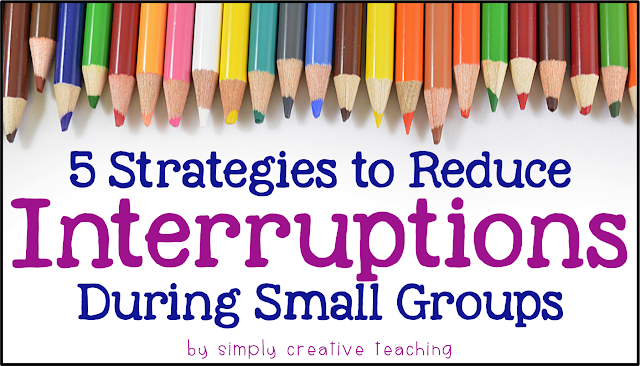Strategies to Reduce Small Group Interruptions
Every year during back to school time I start to get a teensy bit nervous about all of the new little faces that will be coming and how all of their little personalities will play a part in our class family. And oh good gracious, I always stress about how in the world I'm going to make sure I've got my routines and procedures set. So today I thought I'd highlight a few routines and procedures that save my sanity.
These are just a few of my favorite strategies so that I am not getting interrupted nearly as much during my small group time! Please remember that you need to explicitly teach, model, and practice all of these with consistency!I teach my students that if you have a question about your activity, you must ask 3 friends working near you and/or the stations leader (aka the kid who always knows what they're supposed to be doing). Some people make cute name badges for those leaders... I haven't gotten around to that just yet, and I haven't needed to. I just write their names on the board or review who to ask for help before I send students off to stations. 95% of the time this fixes the problem. However, if I have a student that is clearly not listening to the instructions for the activity and is constantly up and asking others what he/she should be doing, then I'll have a private conversation with that student later and handle it individually.
During my first year of teaching our guidance counselor taught my kids the 4 Bs of when to get adult help - Barfing, Bleeding, Behaving Dangerously, or Bullying. I have constantly referred back to those 4 Bs for EVERYTHING. I should also mention the bleeding one must be blood dripping everywhere to interrupt. These 4 Bs also carry over quite well when it comes to tattling. If it's not one of the 4 Bs, I'm not going to hear it.
Every year I tape down an X on the floor off to one side of my small group table. Some teacher use this for students to stand on and wait to be addressed if they need something. Mine is only to be used for emergencies (the 4 Bs) OR if students need to use the restroom. If students need to use the restroom, they must stand on the X, hold up the silent restroom hand signal (index and middle finger crossed), and wait until I make eye contact with them. Once I acknowledge them with eye contact, a simple thumbs up/down tells them that they may/may not use the restroom.
We talk frequently about whether certain issues are kid-sized problems or whether an adult is truly needed in a situation. Sometimes there are extremely silly issues that, I'm sorry, but I'm just not going to interrupt small group time to fix. At the beginning of the year, even before I start meeting with small groups, I ask my students if it is a kid-sized problem. These kinds of things include: pencil broke, Johnny took my red crayon, Annie frowned at me, etc... Figure it out kids. Disclaimer: If Johnny is consistently a red crayon thief or Annie is consistently being mean to others, I deal with those, just not during small groups.
In addition to the X on the floor, I have a little push light and a LED light switch (both from Dollar Tree) that I turn on during small groups. When these are on, my students know that I am working with groups, and we are not to be interrupted. The visual on/off light really helps remind my kiddos.
Your kids can do it! Set high expectations, be consistent, and your students will meet them! Now go give your small groups the full 20 minutes they deserve!






